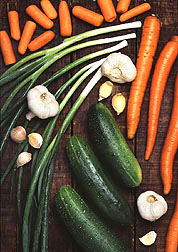Phytonutrients Take Center Stage
|
|
0n the cusp of the millennium, researchers are busily uncovering a host of beneficial compounds in plant foods. While these phytonutrients aren't essential by traditional definitions, they apparently reduce risks of diseases of aging.
For example, the isoflavones in soy products may reduce the risk of heart disease, osteoporosis, and several types of cancer. Certain flavonoids in blueberries may actually reverse nerve cell aging. And a wide array of compounds in fruits and vegetables may protect cell components against oxidative damage as well as vitamins C or E.
Indeed, cancer, heart disease, and Alzheimer's disease may plague the middle-aged and elderly because of our limited knowledge of phytonutrients. Research in this arena, now less than two decades old, may relegate some of today's ills to the history books—joining scurvy and pellagra.
Phytonutrients have provided the impetus for plant and nutrition scientists to work together because foods will continue to be the primary source of these compounds. While a few visionary plant scientists have improved the nutritional quality of foods, breeders have focused on increasing yields or warding off insects or diseases.
That is changing. Projects have sprouted up to screen germplasm for specific phytonutrients or to find ways to increase or preserve them in cultivated varieties. Following are just a few examples of this new wave:
Genetic engineering has produced tomatoes with up to three times more lycopene—the cancer-preventing red pigment—than normal and a shelf life several weeks longer. Autar K. Mattoo and colleagues at the ARS Vegetable Laboratory in Beltsville, Maryland, inserted a gene that retards plant aging, or senescence, along with a promoter that is triggered by ripening. The engineered tomatoes accumulate more lycopene and other antioxidants during the longer ripening stage. This novel approach should work in other fruits and vegetables.
Tissue culture at the ARS Western Regional Research Center in Albany, California, is producing tomatoes with 10 times more lycopene than store-bought tomatoes. Betty K. Ishida and colleagues grow tomatoes in test tubes kept at cooler temperatures, which triggers certain genes to produce the enzymes that increase lycopene production, she says. She is searching for the specific genes responsible and other ways to activate them.
Environmental and genetic factors also make a difference. Cantaloupes grown at the ARS Subtropical Agricultural Research Center in Weslaco, Texas, differed in beta carotene levels by 500 percent, depending on the soil, the cultivar, and fruit size, says Gene E. Lester. Now Lester and colleagues are embarking on a project to understand the postharvest storage factors, as well as the environmental and genetic factors that affect phytonutrient levels in a variety of fruits and vegetables.
Breeding will be central to putting produce with enhanced phytonutrients on the table. Broccoli is a good source of compounds that may inhibit cancer. But there's good potential for increasing the crop's potential anticancer punch. Mark W. Farnham in the ARS Vegetable Research Unit at Charleston, South Carolina, and Jed Fahey at Johns Hopkins University in Baltimore, Maryland, found that the supposed anticancer precursor—glucoraphanin—exhibits a thirtyfold difference in Farnham's inbred broccoli lines.
Storage can affect phytonutrient levels, says Irwin Goldman of the University of Wisconsin. Onions that have been in cold storage up to 90 days show more antiplatelet activity. This can reduce cardiovascular disease risk by interfering with the clumping of blood platelets—the first stage in clot formation.—By Judy McBride, Agricultural Research Service Information Staff.
This research is part of Human Nutrition, an ARS National Program (#107) described on the World Wide Web at http://www.nps.ars.usda.gov/programs/appvs.htm.
Beverly A. Clevidence heads the USDA-ARS Phytonutrients Laboratory, Bldg. 308, 10300 Baltimore Ave., Beltsville, MD 20705-2350; phone (301) 504-8367, fax (301) 504-9098.
Tracing Elements and Vitamins
A Chinese document dating back 5,000 years described goiter—an enlarged thyroid gland—and recommended that afflicted people eat seaweed and burnt sponge—both good sources of iodine. The element, however, was not recognized as dietarily essential until 1850.
Anemia, another deficiency disease, was treated around the 4th century B.C. by giving patients water used to quench heated iron swords. Iron itself was used to treat anemia as early as the 17th century. But the discovery of other essential elements didn't occur until the start of the 19th century. Sodium and potassium were soon followed by the other major minerals—calcium, sulfur, magnesium, and chlorine.
Except for iron and iodine, the essential trace elements—those needed in milligram or microgram quantity daily—remained unknown until the early 20th century. In the 1950s and 1970s, four elements considered toxic food contaminants—selenium, chromium, fluorine, and silicon—gained new respect when found to have a function in the body. And other trace elements are gaining essential status.
Vitamins, like minerals, had been hinted at for millennia. Diseases like beri beri—known in the Orient as early as 2600 B.C.—and scurvy—the sailors' curse—were long believed to be due to toxins from pathogens in the digestive tract. In 1747, British naval surgeon James Lind cured scurvy with lime juice—thus the term "limey" was coined to mean an English sailor.
Hippocrates advocated liver as a remedy for night blindness around the 4th century B.C., but the active component, vitamin A, was not chemically defined until 1913. The 1920s and 30s were ripe for vitamin discovery, accounting for 11 of the 15 vitamins. Now there's a new surge of discovery around health-enhancing compounds in plant foods known as phytonutrients.
"Phytonutrients Take Center Stage" was published in the December 1999 issue of Agricultural Research magazine.







